How to Learn Blockchain Development in the Right Way
- BLOG
- Blockchain
- November 27, 2025
Learning blockchain development feels overwhelming when you do not know where to start. Many beginners jump between theories, fragmented resources, and outdated explanations without gaining the skills needed to build real applications.
A structured approach changes everything. Understanding how to learn blockchain development begins with mastering the right fundamentals, using practical tools, and following a clear roadmap that supports blockchain development for beginners. This guide gives you a direct, beginner-friendly path to becoming a capable blockchain developer without unnecessary confusion.
Contents
- 1 What Is Blockchain Development and Why It Matters Today
- 1.1 Core Purpose of Blockchain Development
- 1.2 Common Responsibilities of Blockchain Developers
- 1.3 Fundamental Mechanics Behind Blockchain Technology
- 1.4 Growing Business Adoption of Blockchain Systems
- 1.5 Career Advantages of Learning Blockchain Development
- 1.6 Key Differences From Traditional Software Development
- 2 The Essential Fundamentals Every Beginner Must Learn First
- 3 A Practical Blockchain Developer Roadmap for 2025
- 4 Unlock the power of blockchain with Webisoft today!
- 5 How to Learn Blockchain Development Step by Step
- 5.1 Step 1: Understand How Blockchain Networks Operate
- 5.2 Step 2: Study How Smart Contracts Execute Logic
- 5.3 Step 3: Build Your First Simple Smart Contracts
- 5.4 Step 4: Connect Contracts to User Interfaces
- 5.5 Step 5: Expand Into More Complex Application Logic
- 5.6 Step 6: Refine Your Code Through Testing and Iteration
- 6 Mastering Smart Contracts and Core Development Concepts
- 7 Blockchain Development Tools You Must Know as a Beginner
- 8 Building Real Projects to Become a Job-Ready Blockchain Developer
- 9 The Best Resources to Learn Blockchain Development
- 10 Common Mistakes Beginners Make and How to Avoid Them
- 10.1 Skipping the Fundamentals Too Early
- 10.2 Relying Only on Theory Instead of Practicing
- 10.3 Ignoring Security Principles From the Start
- 10.4 Trying to Learn Everything at Once
- 10.5 Avoiding Code Reviews and Debugging
- 10.6 Not Understanding Gas Costs and Efficiency
- 10.7 Neglecting Documentation and Standards
- 11 How Webisoft Guides Your Blockchain Development Journey
- 12 Unlock the power of blockchain with Webisoft today!
- 13 Conclusion: Your Path to Becoming a Blockchain Developer
- 14 Frequently Asked Questions
- 14.1 1. Is blockchain development hard to learn for beginners?
- 14.2 2. Do I need strong programming skills before learning blockchain development?
- 14.3 3. How do I start learning blockchain development if I feel overwhelmed?
- 14.4 4. How long does it take to learn blockchain development?
- 14.5 5. What skills are required to become a blockchain developer?
- 14.6 6. Can I learn blockchain development without focusing on multiple networks at once?
- 14.7 7. What is the best way to stay consistent while learning blockchain development?
What Is Blockchain Development and Why It Matters Today
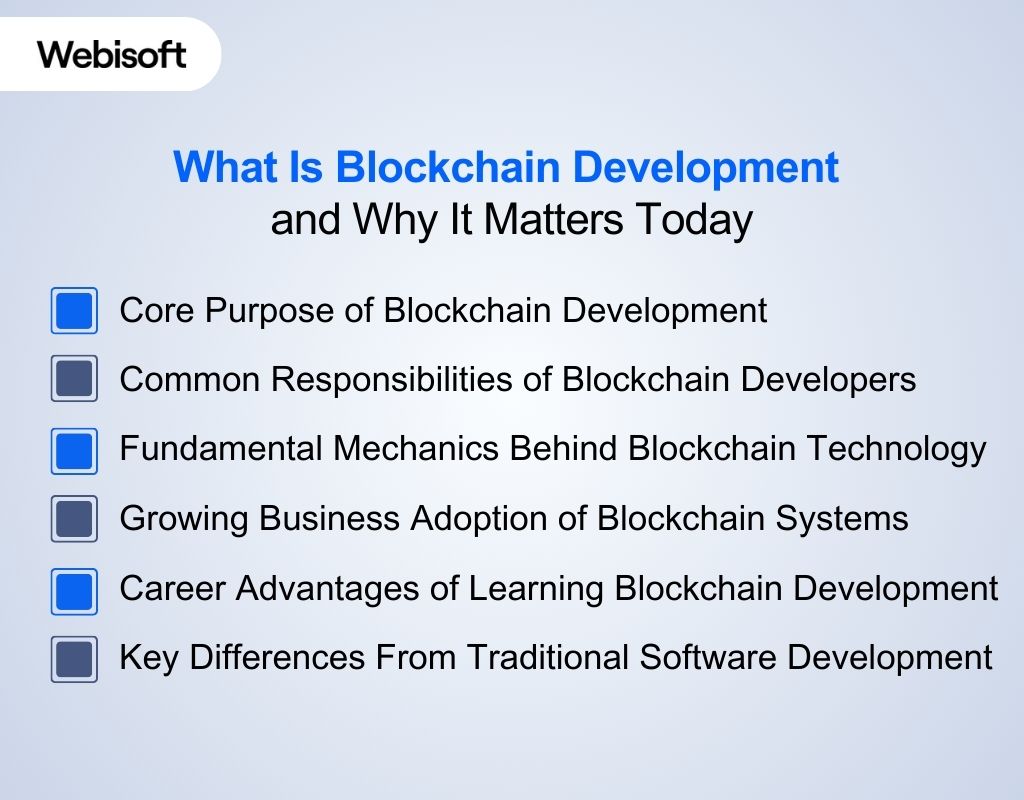 Blockchain development focuses on creating decentralized applications, smart contracts, and systems that operate without a central authority. Understanding this foundation helps you start your learning journey with clarity and prepares you for the skills ahead.
Blockchain development focuses on creating decentralized applications, smart contracts, and systems that operate without a central authority. Understanding this foundation helps you start your learning journey with clarity and prepares you for the skills ahead.
Core Purpose of Blockchain Development
Blockchain development centers on building applications that rely on distributed ledgers, cryptographic security, and automated logic. Developers design systems that ensure data integrity, transparency, and reliable execution across all participants.
Common Responsibilities of Blockchain Developers
Developers build smart contracts, tokens, DeFi systems, identity solutions, and automation logic. They also manage on-chain data structures, test contract behavior, and ensure applications interact smoothly with wallets and decentralized networks.
Fundamental Mechanics Behind Blockchain Technology
Blockchains distribute data across multiple nodes that collectively validate changes. This design prevents silent tampering, increases transparency, and ensures every transaction follows agreed validation rules without depending on a single authority.
Growing Business Adoption of Blockchain Systems
Organizations use blockchain to automate workflows, protect sensitive data, and maintain shared records across partners. This adoption supports more reliable operations, reduces manual reconciliation, and creates trustworthy digital processes.
Career Advantages of Learning Blockchain Development
Demand for blockchain developers continues to rise as Web3 expands. Mastering decentralized logic, smart contract design, and network architecture opens opportunities across finance, gaming, supply chains, and security-focused industries.
Key Differences From Traditional Software Development
Traditional applications rely on centralized databases controlled by one entity. Blockchain development uses decentralized storage, consensus-based validation, and smart contract execution, creating systems that operate with higher transparency and reduced reliance on intermediaries.
The Essential Fundamentals Every Beginner Must Learn First
 Before learning smart contracts or decentralized applications, you need a strong foundation in the fundamentals that power all blockchain systems, especially when exploring how to learn blockchain development step by step. These basics help you understand how the technology works and prepare you for more advanced development tasks.
Before learning smart contracts or decentralized applications, you need a strong foundation in the fundamentals that power all blockchain systems, especially when exploring how to learn blockchain development step by step. These basics help you understand how the technology works and prepare you for more advanced development tasks.
Programming Foundations for Blockchain Development
A solid understanding of programming concepts such as variables, functions, loops, and conditionals is essential. These fundamentals shape how smart contracts execute logic and how decentralized applications handle user interactions.
Core Principles of Cryptography
Blockchain relies heavily on hashing, digital signatures, and public-private key pairs. These cryptographic components secure transactions, verify identities, and ensure every state change follows transparent, verifiable rules across the network.
Understanding Data Structures and Algorithms
Concepts like arrays, mappings, trees, and linked structures play a major role in smart contract logic. Efficient data structures reduce gas costs, improve performance, and help you design contracts that behave predictably under different conditions.
Grasping Distributed Systems and Consensus Models
Blockchains function as distributed networks where nodes must agree on each change. Understanding consensus models such as Proof of Work or Proof of Stake helps you see how transactions become final and why networks remain secure.
Learning Transaction Flow and State Changes
Every blockchain application depends on how transactions alter state. Understanding how blocks form, how gas fees are consumed, and how contract states update ensures you can design predictable and efficient decentralized logic.
Familiarity With Key Blockchain Concepts
Important concepts include immutability, decentralization, finality, and deterministic execution. These ideas define how blockchain applications operate and guide your approach to writing secure, reliable smart contracts.
A Practical Blockchain Developer Roadmap for 2025
 A clear blockchain developer roadmap helps you avoid confusion and learn in an organized, predictable way, giving you a reliable view of how to learn blockchain development efficiently. Instead of jumping between disconnected topics, you progress through logical stages that build your skills steadily and prepare you for real development.
A clear blockchain developer roadmap helps you avoid confusion and learn in an organized, predictable way, giving you a reliable view of how to learn blockchain development efficiently. Instead of jumping between disconnected topics, you progress through logical stages that build your skills steadily and prepare you for real development.
Stage 1: Master the Core Blockchain Concepts
Start by understanding how distributed ledgers, consensus, transactions, blocks, and smart contracts work. These fundamentals give you the mental model needed to interpret development patterns and avoid common beginner mistakes.
Stage 2: Learn How Smart Contracts Function
Once the basics are clear, study how smart contracts store data, execute logic, and interact with users. Understanding functions, events, state variables, and gas usage prepares you for hands-on development.
Stage 3: Build and Test Simple Contracts
Create small projects like a storage contract, token contract, or basic ownership system. These projects teach you how to deploy code, troubleshoot errors, and understand how real blockchain applications behave on-chain.
Stage 4: Progress to Full Decentralized Applications
After mastering small contracts, expand into building DApps that include interfaces, contract interaction layers, and wallet connections. This stage connects your blockchain logic with real user experiences.
Stage 5: Explore Advanced Blockchain Ecosystems
With core skills established, learn how other networks operate. Explore Layer 2 solutions, alternate VM architectures, and cross-chain communication patterns. This prepares you for modern development environments that go beyond a single ecosystem.
Stage 6: Strengthen Your Development Workflow
Improve your workflow by learning debugging tools, testing frameworks, and structured development patterns. A strong workflow ensures reliability, reduces errors, and helps you scale to more complex applications.
Unlock the power of blockchain with Webisoft today!
Book a free consultation and learn, build, and scale secure blockchain solutions effortlessly!
How to Learn Blockchain Development Step by Step
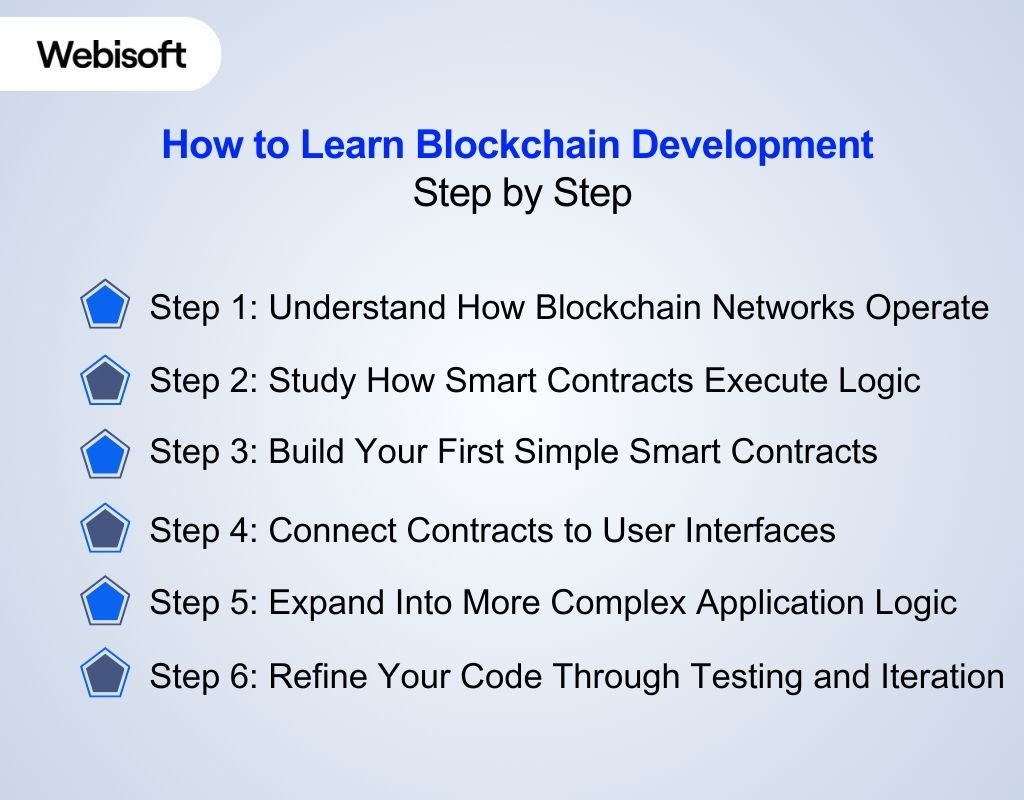 Learning blockchain development step by step helps you absorb concepts without feeling overwhelmed, especially when you understand how to learn blockchain development with a structured flow. Each stage builds on the previous one, giving you a clear and manageable progression toward becoming a capable blockchain developer.
Learning blockchain development step by step helps you absorb concepts without feeling overwhelmed, especially when you understand how to learn blockchain development with a structured flow. Each stage builds on the previous one, giving you a clear and manageable progression toward becoming a capable blockchain developer.
Step 1: Understand How Blockchain Networks Operate
Begin by learning how transactions move through a network, how blocks are created, and how nodes reach consensus. These concepts form the base for everything you will build later.
Step 2: Study How Smart Contracts Execute Logic
Smart contracts run deterministic code that cannot be altered once deployed, which is why beginners must learn smart contract development early in their journey. Learn how they process input, change state, and structure functions so you can design predictable on-chain behaviors.
Step 3: Build Your First Simple Smart Contracts
Start with small contracts that store values, manage ownership, or handle basic transfers. These early exercises teach you how deployment, testing, and contract interaction work in real environments.
Step 4: Connect Contracts to User Interfaces
Once you understand contract behavior, learn to integrate them with user interfaces. This involves sending transactions, reading state, and displaying real-time contract data inside an application.
Step 5: Expand Into More Complex Application Logic
Build larger applications that include token standards, permissions, multi-step interactions, or automated processes. This phase strengthens your ability to architect scalable and secure decentralized systems.
Step 6: Refine Your Code Through Testing and Iteration
Testing ensures your contracts behave correctly under different scenarios. Learn how to simulate transactions, handle edge cases, and update logic efficiently to maintain reliability and reduce vulnerabilities. If you want guidance while building your first blockchain applications, Webisoft provides technical support that helps you move from learning concepts to applying them in real projects. Our engineers help simplify your development path and refine your smart contract logic.
Mastering Smart Contracts and Core Development Concepts
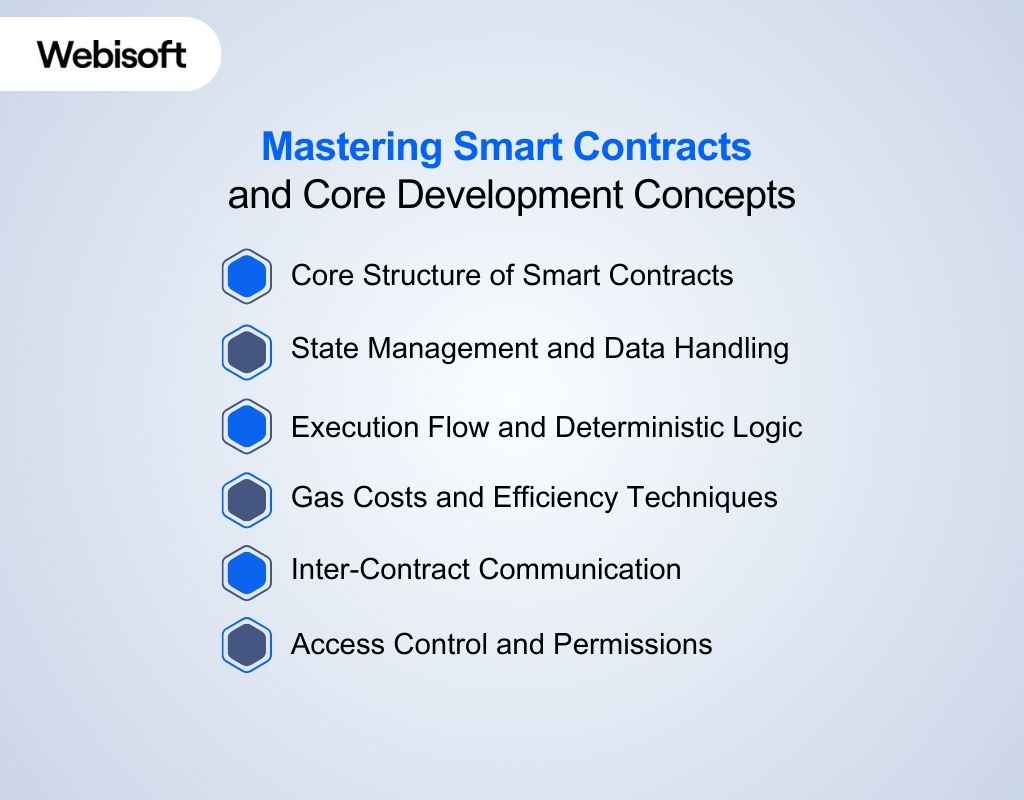 Smart contracts are the backbone of most blockchain applications. Learning how they store data, execute logic, and enforce rules gives you the ability to build secure, predictable systems that users can trust. This section strengthens the skills needed to design reliable contract behavior and helps you learn smart contract development with practical clarity.
Smart contracts are the backbone of most blockchain applications. Learning how they store data, execute logic, and enforce rules gives you the ability to build secure, predictable systems that users can trust. This section strengthens the skills needed to design reliable contract behavior and helps you learn smart contract development with practical clarity.
Core Structure of Smart Contracts
Smart contracts operate using functions, state variables, events, and modifiers. Understanding how these components work together helps you organize contract logic cleanly and write code that behaves consistently across different interactions.
State Management and Data Handling
Contracts store data directly on the blockchain, making storage decisions important for cost and performance. Learning how to manage state variables, mappings, and structs helps you control how applications process and retain information.
Execution Flow and Deterministic Logic
Every smart contract must produce the same result every time given the same inputs. Deterministic logic ensures predictable outcomes, simplifies testing, and prevents unpredictable behaviors that can break decentralized applications.
Gas Costs and Efficiency Techniques
Each contract interaction consumes gas based on data storage, computation, and execution complexity. Writing efficient code reduces fees, speeds up execution, and improves the user experience, especially in high-traffic environments.
Inter-Contract Communication
Smart contracts often call other contracts to coordinate tasks or share data. Understanding how contracts interact helps you design modular applications that maintain security while supporting more advanced features.
Access Control and Permissions
Access rules define who can run specific functions. Implementing secure permissions prevents unauthorized actions, protects critical operations, and ensures your application behaves safely in decentralized environments.
Blockchain Development Tools You Must Know as a Beginner
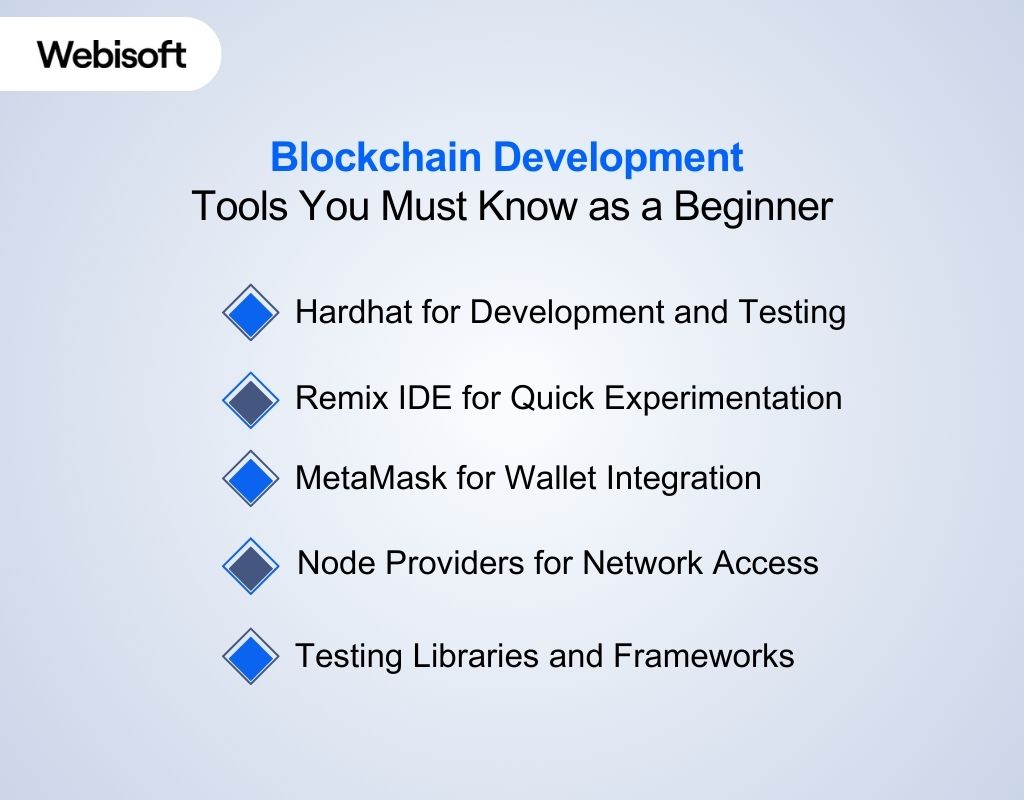 The right tools make blockchain development faster, clearer, and easier to learn. These tools help you write smart contracts, test applications, manage deployments, and interact with local or live blockchain networks during development.
The right tools make blockchain development faster, clearer, and easier to learn. These tools help you write smart contracts, test applications, manage deployments, and interact with local or live blockchain networks during development.
Hardhat for Development and Testing
Hardhat provides a flexible environment for compiling, testing, and deploying smart contracts. Its local blockchain simulation allows you to debug contract behavior, run scripts, and test advanced scenarios without relying on external networks.
Remix IDE for Quick Experimentation
Remix runs directly in the browser and helps beginners write, test, and deploy contracts instantly. Its built-in warnings, debugging tools, and clear interface make it easy to understand how contract logic works in real time.
MetaMask for Wallet Integration
MetaMask serves as a bridge between applications and blockchain networks. It lets you sign transactions, switch networks, store test assets, and interact with smart contracts through a trusted interface used across the Web3 ecosystem.
Node Providers for Network Access
Node providers allow your applications to communicate with blockchain networks without running your own node. They provide reliable RPC access so you can query state, broadcast transactions, and test your applications under real conditions, which is essential for anyone exploring how to learn blockchain development effectively.
Testing Libraries and Frameworks
Testing libraries help you simulate contract calls, validate functions, and ensure your logic behaves correctly. Writing tests early improves reliability, reduces errors, and makes contract behavior easier to maintain as your projects grow.
Building Real Projects to Become a Job-Ready Blockchain Developer
 Real projects turn theory into practical skill. Each project teaches you how blockchain applications behave, how smart contracts interact with users, and how decentralized systems respond to real-world scenarios. Building consistently is the fastest way to become job-ready.
Real projects turn theory into practical skill. Each project teaches you how blockchain applications behave, how smart contracts interact with users, and how decentralized systems respond to real-world scenarios. Building consistently is the fastest way to become job-ready.
Starting With Small, Controlled Projects
Begin with simple applications such as storage contracts, counters, or ownership-based logic. These projects teach you how deployment works, how functions update state, and how contracts handle basic transactions.
Creating Token and NFT-Based Applications
Tokens and NFTs follow clear standards that make them ideal learning projects. Building them helps you understand supply control, transfers, ownership tracking, and event emission, forming a strong foundation for more advanced contract development.
Developing Governance or DAO-Style Logic
DAO voting systems introduce multi-user participation, permissions, and proposal handling. These projects teach you how to manage user interaction, store collective decisions, and maintain transparent, community-driven processes.
Exploring DeFi-Inspired Mini Applications
Replicating simple swapping, staking, or lending mechanics exposes you to real financial logic. Even small prototypes help you understand pricing rules, liquidity behavior, and secure interaction patterns that power larger DeFi systems.
Building Full Decentralized Applications With Frontends
Connecting a contract to a user interface shows how wallets, signatures, and state updates work together. Understanding this flow prepares you for building complete applications with both on-chain and off-chain components.
Expanding Into More Complex Multi-Contract Systems
As your skills grow, build applications that combine multiple contracts. This teaches you event communication, shared state patterns, and coordination between different modules, improving your ability to architect scalable blockchain solutions.
The Best Resources to Learn Blockchain Development
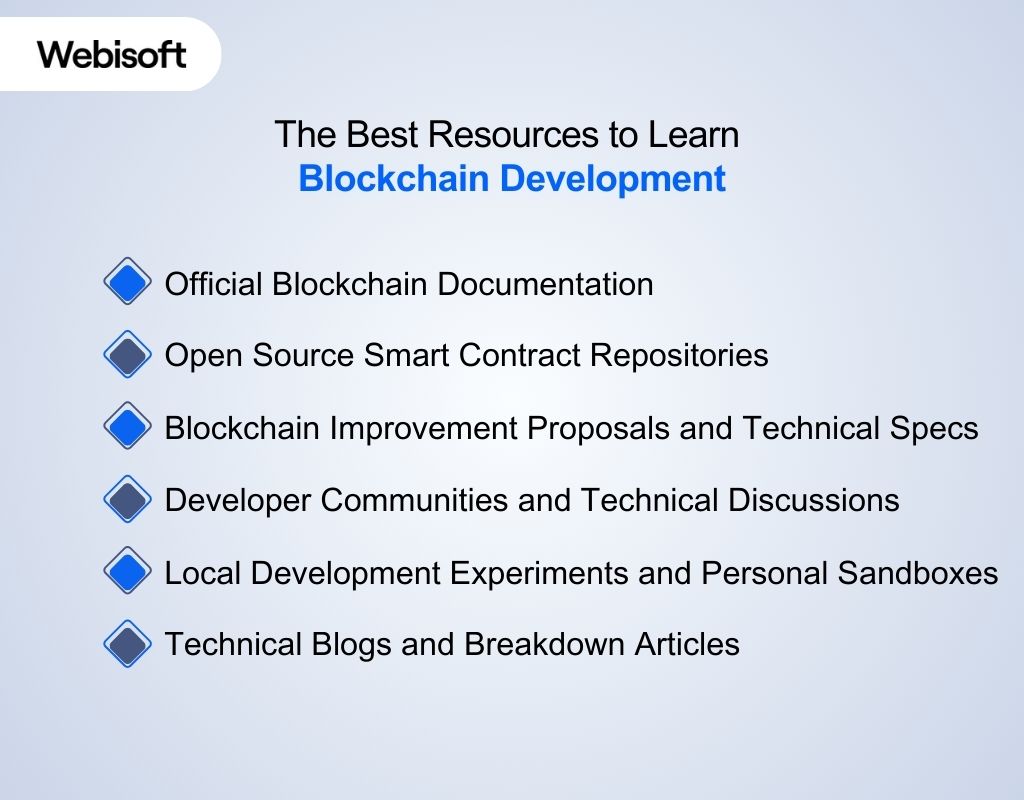 Learning blockchain development does not require paid programs or structured classes. The most reliable resources are the ones developers use daily to build real applications. These references help you learn directly from official standards, practical examples, and active communities.
Learning blockchain development does not require paid programs or structured classes. The most reliable resources are the ones developers use daily to build real applications. These references help you learn directly from official standards, practical examples, and active communities.
Official Blockchain Documentation
Platform documentation provides the most accurate and up-to-date learning material. It explains network architecture, smart contract behavior, transaction flow, and development guidelines directly from the core teams maintaining each blockchain.
Open Source Smart Contract Repositories
Browsing real project repositories helps you understand how production contracts are structured, tested, and optimized. Studying proven patterns teaches you practical techniques used by experienced developers building high-value applications.
Blockchain Improvement Proposals and Technical Specs
Improvement proposals reveal why certain standards, features, and design choices exist. Reading these documents deepens your understanding of token rules, contract interfaces, network upgrades, and system behavior.
Developer Communities and Technical Discussions
Communities provide insights into best practices, common mistakes, and current development challenges. Participating in discussions helps you stay updated while learning how developers solve real problems in active environments.
Local Development Experiments and Personal Sandboxes
Running private blockchain environments allows you to test ideas safely. Experimenting with deployments, simulations, and contract interactions builds confidence and helps you learn faster than relying on external tutorials.
Technical Blogs and Breakdown Articles
Well-written technical articles explain complex concepts with clarity. They offer deep dives into architecture, optimization, testing methods, and contract security patterns, helping you refine your understanding over time.
Common Mistakes Beginners Make and How to Avoid Them
 Many beginners struggle with blockchain development because they rush into advanced topics or follow scattered learning paths. Understanding these common mistakes helps you avoid wasted time and build skills with clarity and confidence.
Many beginners struggle with blockchain development because they rush into advanced topics or follow scattered learning paths. Understanding these common mistakes helps you avoid wasted time and build skills with clarity and confidence.
Skipping the Fundamentals Too Early
Some beginners jump straight into smart contracts without understanding blockchain basics. This leads to confusion and errors. Building a strong foundation first helps you write cleaner logic and understand how your applications really work.
Relying Only on Theory Instead of Practicing
Reading alone will not make you a blockchain developer. Without frequent hands-on practice, concepts remain abstract. Writing small contracts, testing interactions, and experimenting locally accelerates real understanding.
Ignoring Security Principles From the Start
Beginners often overlook security because it feels complex. Weak access control, poor validation, or unsafe patterns lead to serious vulnerabilities. Learning safe practices early prevents issues that are harder to fix later.
Trying to Learn Everything at Once
Blockchain covers many areas, and beginners sometimes attempt to study multiple networks, frameworks, and advanced topics simultaneously. Focusing on one structured path reduces overwhelm and improves long-term learning.
Avoiding Code Reviews and Debugging
Some beginners are hesitant to debug or review code because it feels challenging. Debugging teaches how contracts behave under different conditions and reveals logic issues that tutorials alone will never show.
Not Understanding Gas Costs and Efficiency
New developers often write inefficient code without understanding gas usage. Learning how operations consume gas helps you optimize smart contracts, reduce user costs, and create more scalable applications.
Neglecting Documentation and Standards
Beginners sometimes ignore official documentation and token standards. These resources contain essential rules that guide how applications interact. Following standards ensures compatibility and reduces development mistakes.
How Webisoft Guides Your Blockchain Development Journey
 Learning blockchain development becomes easier when you have the right technical direction. Webisoft helps you move from foundational understanding to real project execution with guidance built around clarity, structure, and practical blockchain development experience.
Learning blockchain development becomes easier when you have the right technical direction. Webisoft helps you move from foundational understanding to real project execution with guidance built around clarity, structure, and practical blockchain development experience.
Structured Development Support
Webisoft provides technical planning and architecture guidance to help you build blockchain applications with confidence. Our team supports your learning path by simplifying complex concepts and aligning them with real development practices.
Expert Smart Contract Engineering
Our engineers help you understand smart contract design, efficiency considerations, and secure development patterns. This support strengthens your understanding of how reliable on-chain logic is built and maintained.
Hands-On Guidance for Real Projects
Webisoft assists with building, testing, and improving blockchain applications so you gain practical experience. This helps you grow faster and produce development work that matches industry expectations. Book a free consultation with Webisoft today and take your blockchain development skills to the next level.
Unlock the power of blockchain with Webisoft today!
Book a free consultation and learn, build, and scale secure blockchain solutions effortlessly!
Conclusion: Your Path to Becoming a Blockchain Developer
Learning blockchain development becomes far more manageable when you follow a clear, structured approach that explains how to learn blockchain development effectively. By building strong fundamentals, mastering smart contract concepts, and practicing with the right tools, you develop the skills needed to understand how decentralized applications truly work.
Each section of your learning journey adds another layer of confidence. As you progress through essential concepts, work with real environments, and refine your understanding of blockchain systems, you prepare yourself for real opportunities in the growing Web3 landscape.
Stay consistent, build often, and continue exploring advanced patterns at your own pace. With steady progress, you can become a capable blockchain developer ready to contribute to projects that rely on transparency, security, and decentralized logic.
Frequently Asked Questions
1. Is blockchain development hard to learn for beginners?
Blockchain development feels challenging at first because it introduces new concepts like decentralization, consensus, and smart contracts. With a structured learning path and consistent practice, beginners can understand these ideas more easily.
2. Do I need strong programming skills before learning blockchain development?
Basic programming knowledge is important because smart contracts rely on core concepts like functions, variables, and control flow. You do not need to be advanced, but you should understand foundational coding principles.
3. How do I start learning blockchain development if I feel overwhelmed?
Start with fundamentals like blockchain structure, transactions, and smart contract basics. Then practice in small steps using local environments. Focusing on one concept at a time removes the overwhelm.
4. How long does it take to learn blockchain development?
The timeline depends on your background. Developers with prior coding experience can learn the fundamentals in a few months, while complete beginners may need longer. Consistent practice and a clear learning structure matter more than speed.
5. What skills are required to become a blockchain developer?
Key skills include programming fundamentals, smart contract design, understanding blockchain mechanics, gas optimization, testing patterns, and security awareness. These skills help you write reliable and efficient decentralized applications.
6. Can I learn blockchain development without focusing on multiple networks at once?
Yes. It is better to focus on one ecosystem initially. Learning one environment well makes it easier to explore other chains later, since most core concepts transfer across ecosystems.
7. What is the best way to stay consistent while learning blockchain development?
Set small goals, build simple projects, and review your code regularly. Steady progress and hands-on practice help you stay engaged and develop skills at a comfortable pace.


